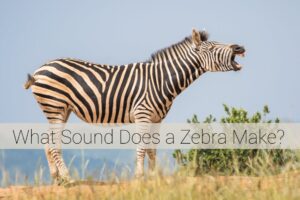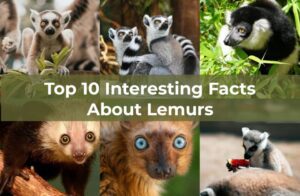Wildlife comes in different shapes, sizes, and appearances, but some animals are known for their iconic big eyes.
Some of these animals appear cute and sometimes creepy because of the shape of their eyes.
In this article, we will look at the top 10 animals with eyes and also learn a few things about them.
The Top 10 Animals with Big Eyes
1. Tarsier

Scientific Name: Tarsiidae
Tarsiers are small, cute-looking primates that are found throughout Southeast Asia. They are known for their large eyes, which makes them appear unique.
Their eyes are not just big; they help them move around and hunt in the dark. They prefer to hunt at night and have evolved the ability to rotate their heads almost 180 degrees.
Tarsiers are mostly found in countries like Brunei, Indonesia, Malaysia, and the Philippines, where they live in forested areas.
They are known as being shy and reclusive, so they prefer not to be seen in the wild. Tarsiers prey on small forest animals like lizards, beetles, frogs, and others.
2. Giant Squid

Scientific Name: Architeuthis dux
Another animal that falls under this category is the giant squid. This large deep-ocean dwelling squid can reach a maximum of 12–13 m (39–43 ft) in size.
The eyes of giant squids can be as large as a dinner plate, up to 27 cm (about 10.6 in). They use these large eyes to detect faint light as they swim in the deep sea.
This means their large eyes serve as a built-in pair of high-powered binoculars.
Although giant squids are large, their tentacles contribute to most of their length. The total length of a giant squid, including the head and arms and without the tentacles, can reach 16 ft.
3. Owls

Order: Strigiformes
Owls are known for their big, forward-facing eyes. Their eyes give them incredible binocular vision.
These birds are divided into two families, Strigidae and Tytonidae. Although the shape and colour of their eyes might be different for each species, they still have binocular vision.
This eye is better suited for swooping down on prey with pinpoint accuracy.
Another interesting fact about owls is that they can rotate their heads up to 270 degrees to look around. This gives them an overall view of the environment without moving their bodies.
4. Mouse lemurs

Scientific Name: Microcebus
A mouse lemur is one of the Madagascar animals with big eyes. This lemur species looks like a large mouse.
They have large eyes that make them appear cute. If you are a fan of animated cartoons, you will recognise the character named Mort in the Penguins of Madagascar movies. Mort is a mouse lemur and is mostly seen beside King Julian (Ring-tailed lemur) and Maurice (aye-aye lemur).
Mouse lemurs are nocturnal lemurs, so their eyes help them see better at night.
Their diet consists of fruits, nectar, insect secretions, arthropods, small vertebrates, and flowers.
Mouse lemurs are also the smallest primates in the world. They have a combined head, body, and tail length of 7.9–11.8 in.
5. Sportive lemurs

Scientific Name: Lepilemur
Sportive lemurs are another lemur species with noticeable large eyes. Just like the previous animal, sportive lemurs are only found in Madagascar.
These lemurs have large, orange-like eyes that they use to see in the dark. Their pupils appear to glow when light shines into their eyes.
At night, they move from tree to tree to feed on leaves. Sportive lemurs can be identified by their grey-brown or reddish-coloured back and whitish-yellow underside.
6. Aye-aye

Scientific Name: Daubentonia madagascariensis
Another Madagascar animal with big eyes is the aye-aye lemur. This lemur has a unique appearance that is different from other primates.
The aye-aye are nocturnal lemurs that spend most of their lives high in the trees. They are known to perform basic tasks like sleeping, eating, and travelling in the trees.
These lemurs are omnivores, which means they feed on both plant and animal matter such as seeds, nuts, fruits, nectar, fungi, and insect larvae.
7. Horse

Scientific Name: Equus ferus caballus
Horses are one of the animals with big eyes. Their eyes are one of the largest of any land mammal.
They can reach high speeds to escape danger, which led to horses being domesticated to aid in movement in the past and even today.
Horses have their eyes on the sides of their heads, which makes it possible for these hoofed mammals to see more than 350 degrees. This feature helps them avoid predators in the wild by providing a clear view of their surroundings.
Horses are also able to see clearly during the day and at night. They are known to have just two-colour vision, which means certain colours like red appear as a shade of green.
Although horses have excellent vision, they have a small blind spot directly in front of and behind them.
8. Tree Frog
Tree frogs are small frog species that live on trees. They have large eyes that bulge from their heads.
These eyes and their position give tree frogs an excellent field of vision, which they use to spot insects and avoid predators.
Some species of tree frogs have eyes that glow in the dark, enabling them to move at night.
9. Cats

Scientific Name: Felis catus
Cats, also known as domestic cats or house cats, are another animal with large eyes. These popular pets are known for their eyes, which appear large due to their proportion to their heads.
Their eyes are better suited for night vision. This is why they are also able to hunt in low-light conditions.
Cats can dilate their pupils as light intensity changes, making them effective nighttime hunters.
10. Bush Baby

Scientific Name: Galagidae
Bush babies are also known as Galagos. They are small nocturnal primates that are native to native Africa.
This animal has oversized eyes that they use to see in the dark. Bush babies look cute and cuddly when they are seen in the wild, but there are many myths about them in Africa.
If you hear a bush baby cry, you can easily get confused and mistake it for a baby. In African countries like Nigeria, there is a myth that bush babies can never be found dead on plain ground.
Bonus
One benefit of reading my articles to the end is that I always have a bonus animal.
Slow Loris

Genus: Nycticebus
Slow lorises are nocturnal primates that are found throughout Southeast Asia in places like the Philippines, Bangladesh, and Northeast India.
They are known for their round head, narrow snout, and large eyes. Animals classified under the Lorisidae family have large eyes. Examples are pottos.
Although slow lorises look innocent, they have a toxic bite. The toxins from their bite can be harmful to predators.
Conclusion
Almost all animals have a unique appearance and features that help them survive. In this article, I have covered the top 10 animals with big eyes.
In summary, the animals with big eyes are Tarsiers, Giant Squid, Owls, Mouse lemurs, Sportive lemurs, Aye-aye, Horses, Tree Frogs, Cats, Bush Babies, and Slow Lories.
FAQs
Why do some animals have big eyes?
Most animals have big eyes to enhance their vision, especially in low-light conditions. This adaptation helps them hunt, avoid predators, and move around more effectively.
Do big eyes help animals see farther?
Big eyes can help animals see more clearly and gather more light, which can improve their vision when it is dark. They don’t necessarily help them see farther than animals with smaller eyes.
Are there any other animals with big eyes that weren’t mentioned in this list?
Yes, there are many other animals with big eyes, including the ringtail, dragonfly, and certain species of fish.

Hi, I’m Louis Ojibe, and I grew up around wildlife in Africa. I have always been fascinated by animals and nature across the world.
As a child, my parents used to take me to see wild animals like lions, elephants, gorillas, tortoises, and many others at our local zoo.













